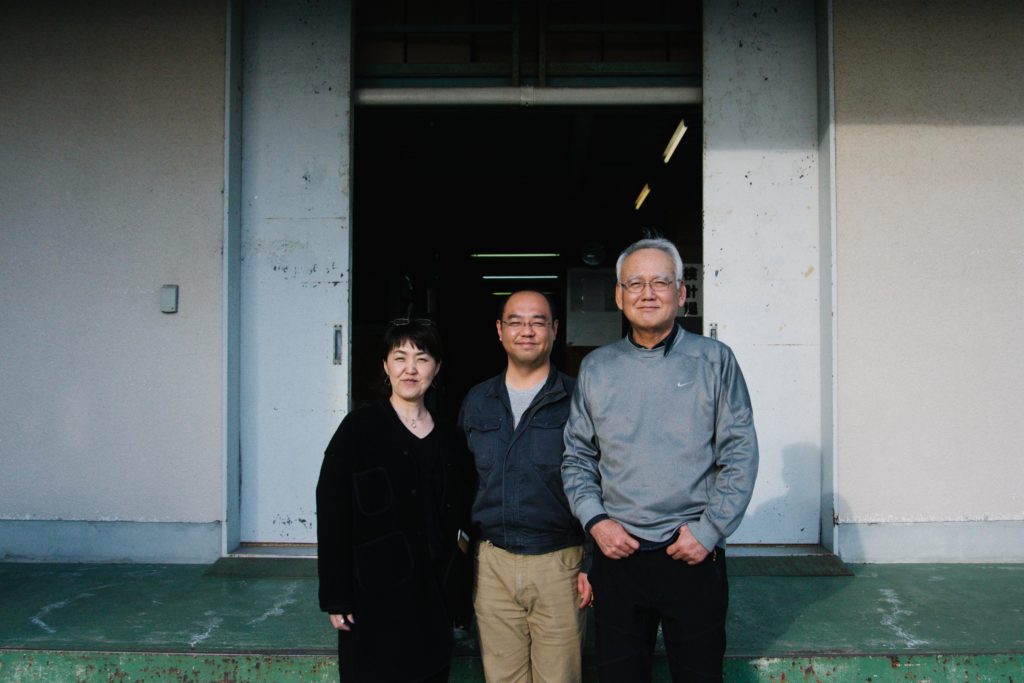Socks are something we wear every day. They are now such an indispensable part of our daily lives, yet we rarely think about their origins.
The origin of socks in Japan is believed to be akin to “tabi” (Japanese split-toe socks), called “Shito-uzu”, brought over from China around the 5th century. At that time, only a few nobles, such as town elders were allowed to wear them. In the 16th century, European hand-knitted socks were introduced through the Nanban trade (trading with Europe during Japan’s isolation period). However, it was not until the Meiji era (1868-1912) that they became accessible to the general public.
The development of machinery, the export of socks that was vital to earning foreign currency, and the growing military demand boosted domestic production and popularity of the product. Even so, a pair of socks was 10 sen (the cost of 5kg of rice at that time), so only soldiers, aristocrats, doctors and other affluent people could obtain them.
In Hyogo, the area around present-day Kakogawa City was the heart of sock manufacturing. In the Edo period (1603-1868), the cultivation of Himeji cotton flourished, thanks to the mild climate and low rainfall. The export of salt, rice, and cotton (called “the three whites of Banshu”) boosted the finances of the domain.
In the Meiji era (1868-1912), along with the development of textiles, the production of socks began, making use of readily available cotton. It began as a side business for the farmers, but with the convenience of the nearby Port of Kobe, the sock industry gradually became more organized.
In other words, the framework for sock production in Hyogo was set: a climate perfect for cotton cultivation, the technology and human resources for production, and an access to export routes.
Though the sock industry was flourishing since the end of World War 2, the center of the world’s sock production has now shifted to China. With China’s machine performance, production speed and cost being less competitive compared to other countries, it has led to the decline of Japan’s sock factories.
In these changing times, it’s an opportunity to try out new ideas, like manufacturing methods or new business models, whilst maintaining regular production. One of these new ideas comes from a woman who makes socks from a completely new perspective, one that may give us a hint about the future of manufacturing.

There is a woman in Hyogo, named Tamami Takeoka, who makes mysterious socks. After working for an advertising company, she did freelance package design and product planning. Now, this mother of two is developing a sock brand called “Hibi no kunekune socks (lit. Daily Wriggly Socks)”. Upon seeing them, the craftsman said, “These aren’t socks,” because he had never seen anything like this before.
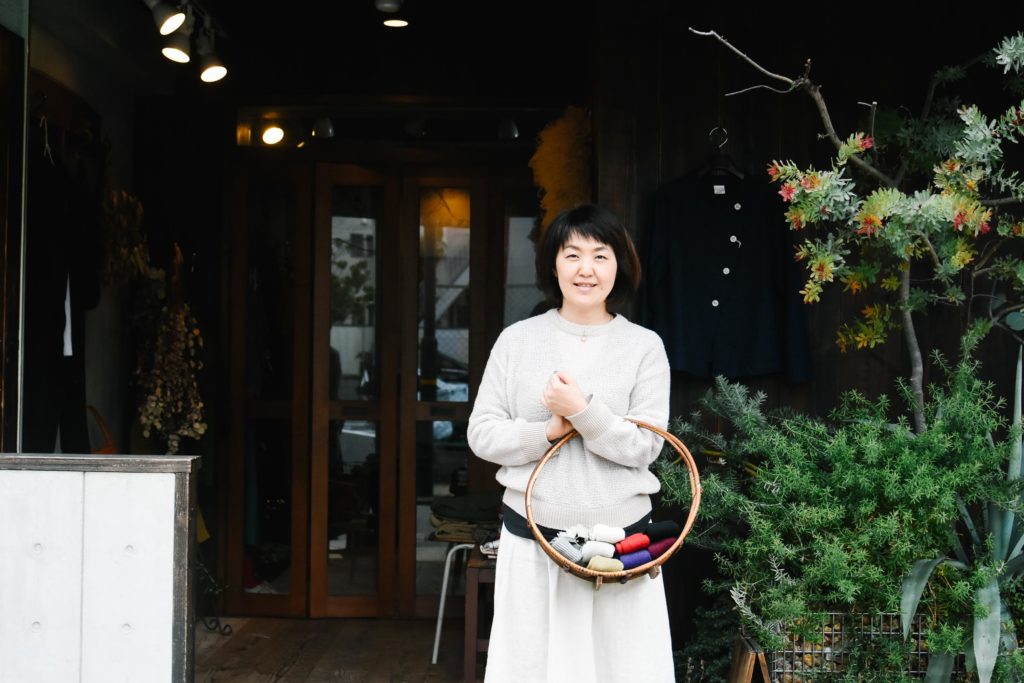
“Hibi no kunekune socks” are defined by three main characteristics:
They come in beautiful colors and shapes, and are practical, non-restrictive, and breathable.
“I followed the craftsman around persistently, that’s how these socks were created.”
Ms. Takeoka knew nothing about sock-making, so she went to Mr. Tomonobu Nakatani (Inasaka Meriyasu Co., Ltd.), a veteran craftsman of more than 50 years, to learn the craft. Looking back, Ms. Takeoka says that the biggest benefits of those days were the conversations she had with Mr. Nakatani while working. She was able to communicate not only the physical image of the socks she wanted to produce, but the feelings she wanted to invoke.

Socks are normally steamed or pressed by an iron as a final step before shipping. However, Ms. Takeoka discovered that doing so stresses the backing elastic threads. “Let’s stop that process,” she suggested, resulting in misshapen socks. Taking the opportunity to name her new creation, she thought of the name “Kunekune socks”, meaning wriggly socks.
In doing so, she challenged the notion of a “good” product without compromising on the quality, changing the common belief that “non-uniform = defective”.
The Key to Manufacturing: Manufacturers that Share Your Vision
China is currently the center for manufacturing. They have the latest machines, precise image detailing, and fastest production speed. So, what was the point of manufacturing in Hyogo?
“To work with craftsmen who share the same vision of what we want to make,” Ms. Takeoka answered with a smile. The “image” in my head is conveyed through words, and the craftsmen replace the words with “form”. The accuracy of this “communication game” might prove to be difficult for those that have differing languages, cultural backgrounds, or physical proximities. Ms. Takeoka has come to realize the importance of a common vision and the nuances of language used in manufacturing.
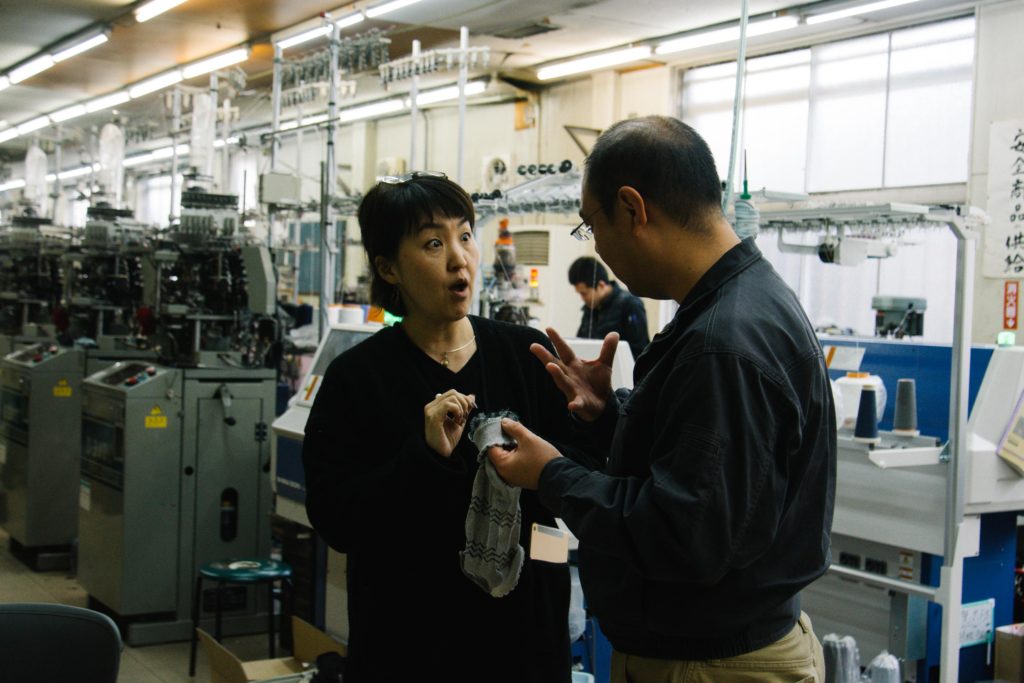
Ms. Takeoka of “monoko”, engrossed in a conversation about socks with a factory staff
Currently, Ms. Takeoka works with two different sock manufacturers. The manufacturers will be introduced in separate parts.(Read Part 2 here)。
The sock industry is so deeply rooted in Kakogawa City that people in the Hyogo prefecture automatically associate this city with socks. Nihon Amimono Co., Ltd. has been manufacturing socks here for about 100 years.

A quiet view of the scenery around Nihon Amimono, Kakogawa River flowing on the right.
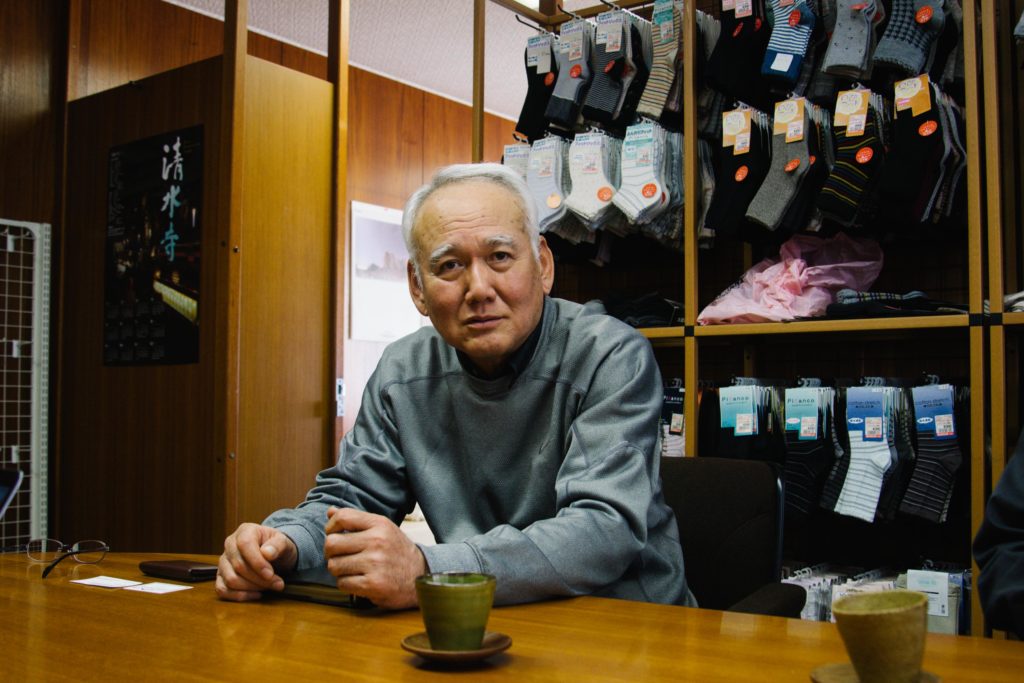
Masahiro Kakitsubo, Representative Director of Nihon Amimono Co., Ltd, manufacturer of “monoko” socks.
“At first, we worked in the fields by day, making socks with a hand-operated machine by night. If you look at photos of the village from that era, you’ll see that people wore sandals or were barefoot, even in winter.” It was under these circumstances that sock manufacturing began. Mr. Kakitsubo recalls with a laugh: “When we didn’t have enough yarn, we had to unstitch our stockings!”
They develop hundreds of sock designs every year, and are always thinking about new socks to make. Mr. Kakitsubo’s son, the future 6th generation head, is also involved in production. One gets the sense that this family has been and will be in this industry for a long time to come.
They are currently manufacturing “monoko”’s five-toe socks as well as socks with details that can only be produced with computerized machines.

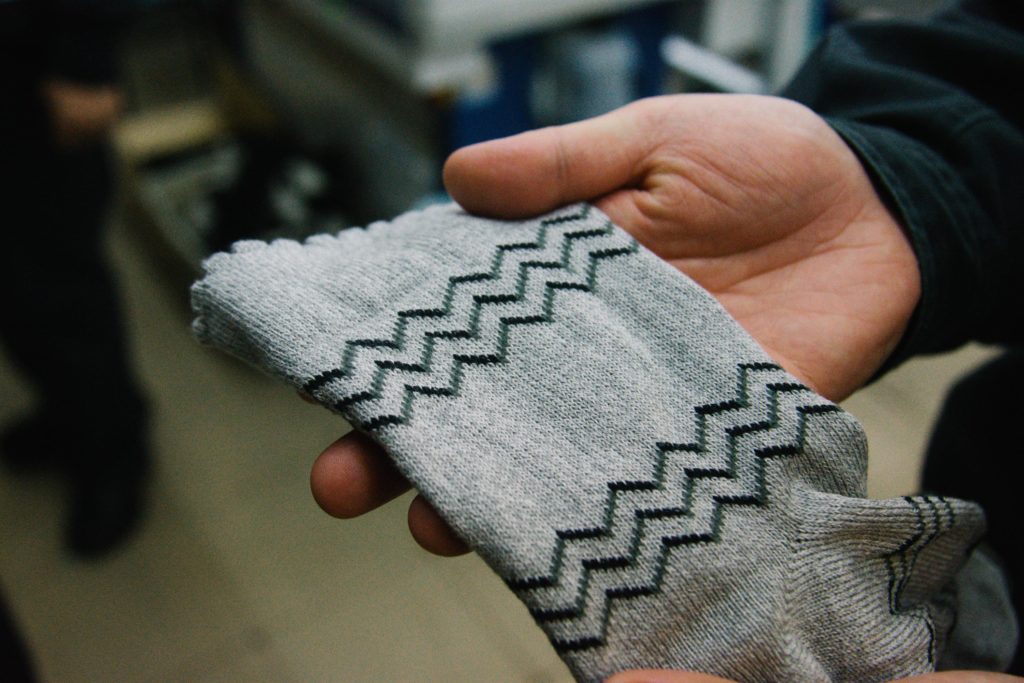
The words of Mr. Kakitsubo stayed in my mind. Although the Japanese factory is still in operation, most of the socks are now manufactured by a partner company in China. While utilizing the technology they have cultivated over the years, they control the product development and perform in-house quality checks.
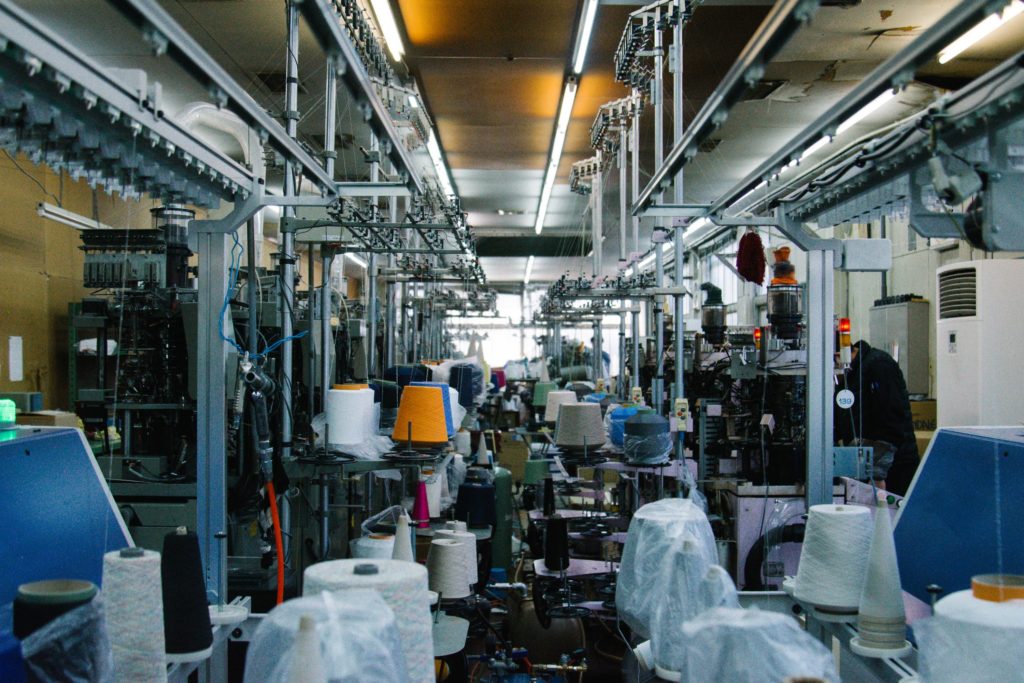
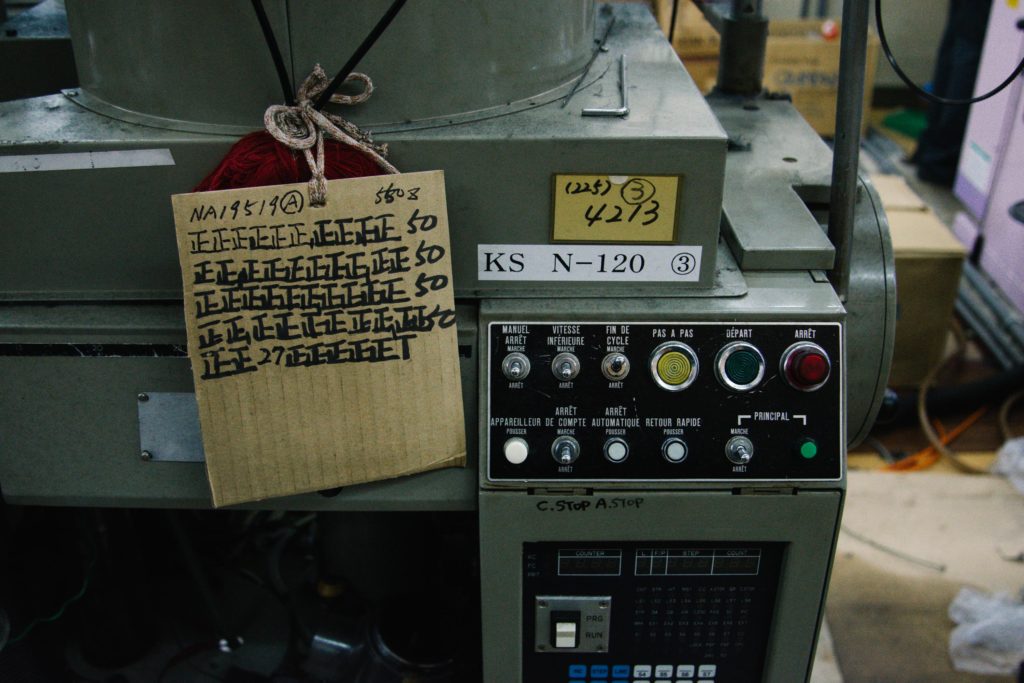
“The average lifespan of a modern computerized machine is 20 years at most. Calculating the amount produced per day, wondering if I can break even… I feel like the sturdy old machines are more astonishing,” Mr. Kakitsubo laments. “In the long run, machines will change, but technique and information remain. Knowledge and skill accumulated over 100 years will not evaporate so easily.”
There is a strength and dedication in his eyes as he declares these words.

Mr. Kakistubo’s dream is to one day make socks that are produced entirely in Japan, from the cotton plants to manufacturing. He has actually launched a project in Kakogawa City called ALL NIPPON, producing socks using locally sourced materials. However, the production cost is still higher than foreign-made socks, so he has to continue to seek other methods.
While he has full trust in the possibility of “Made in Japan”, Mr. Kakitsubo’s eyes glimmer with a hope: to return to the roots of the Banshu region, a place that once thrived with cotton plantations.
